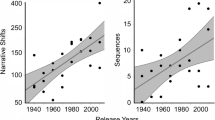Abstract
This work constitutes the first attempt to extract the important narrative structure, the 3-Act storytelling paradigm in film. Widely prevalent in the domain of film, it forms the foundation and framework in which a film can be made to function as an effective tool for story telling, and its extraction is a vital step in automatic content management for film data. The identification of act boundaries allows for structuralizing film at a level far higher than existing segmentation frameworks, which include shot detection and scene identification, and provides a basis for inferences about the semantic content of dramatic events in film. A novel act boundary likelihood function for Act 1 and 2 is derived using a Bayesian formulation under guidance from film grammar, tested under many configurations and the results are reported for experiments involving 25 full-length movies. The result proves to be a useful tool in both the automatic and semi-interactive setting for semantic analysis of film, with potential application to analogues occuring in many other domains, including news, training video, sitcoms.
Similar content being viewed by others
References
B. Adams, C. Dorai, and S. Venkatesh, “Towards automatic extraction of expressive elements from motion pictures: Tempo,” in IEEE International Conference on Multimedia and Expo, 2000, Vol. II. pp. 641–645.
B. Adams, C. Dorai, and S. Venkatesh, “Formulating film tempo-The computational media aesthetics methodology in practice,” in Media Computing: {Computational Media Aesthetics}, Kluwer Academic Publishers, 2002, pp. 57–84.
D. Arijon, Grammar of the film language, Silman-James Press, 1976.
L. Aronson, Scriptwriting Updated: New and Conventional Ways of Writing for the Screen, Allen and Unwin, 2000.
C. Dorai and S. Venkatesh, “Computational media {Aesthetics}: Finding meaning beautiful,” IEEE Multimedia, Vol. 8, No. 4, pp. 10–12, 2001.
C. Dorai and S. Venkatesh, “Bridging the Semantic Gap in Content Management Systems-Computational Media Aesthetics,” in Media Computing: {Computational Media Aesthetics}, Kluwer Academic Publishers, 2002.
S. Field, Screenplay: The Foundations of Screenwriting, 3rd Ed, Dell Publishing, 1994.
W. Goldman, Adventures in the Screen Trade: A Personal View of Hollywood. Abacus, 2000.
IBM, “Made to Order: IBM makes sense of unstructured data,” 2002, http://www.research.ibm.com/thinkresearch/pages/2002/20020308_unstructured.shtml.
A. Jain, R. Duin, and J. Mao, “Statistical pattern recognition: A review,” IEEE Transactions on Pattern Analysis and Machine Intelligence, Vol. 22, No. 1, pp. 4–37, 2000.
C. Keane, How To Write a Selling Screenplay: A Step by Step Approach to Developing Your Story and Writing Your Screenplay by One of Today’s Most Successful Screenwriters and Teachers, Broadway Books, 1998.
Y. Li, W. Ming, and C.-C. Kuo, “Semantic video content abstraction based on multiple cues,” in IEEE International Conference on Multimedia and Expo 2001, ICME2001. Tokyo, Japan, 2001, pp. 804–807.
R. Lienhart, S. Pfeiffer, and W. Effelsberg, “Scene determination based on video and audio features,” in EEE Multimedia Computing and Systems, ICMCS99, Florence, Italy, 1999.
R. McKee, Story: Substance, Structure, Style, and the Principles of Screenwriting, ReganBooks, 1997.
M. Mehring, The Screenplay: A Blend of Film Form and Content, Focal Press, 1990.
J. Monaco, How to read a film: The Art, Technology, Language, History and Theory of Film and Media, Oxford University Press, 1981.
M. Skov and P. Andersen, “Designing Interactive Narratives,” in COSIGN 2001.
T. Sobchack and V. Sobchack, An introduction to film, Scot, Foresman and Company, 1987.
K. Thompson, Storytelling in the New Hollywood: Understanding Classical Narrative Technique, Harvard University Press, 1999.
C. Vogler, The Writer’s Journey: Mythic Structure for Storytellers and Screenwriters, Revised and Expanded, Pan Books, 1999.
R. Winkler, Introduction to Bayesian Inference and Decision, Holt, Rinehart and Winston, Inc, 1972.
Author information
Authors and Affiliations
Corresponding author
Rights and permissions
About this article
Cite this article
Adams, B., Venketesh, S., Bui, H.H. et al. A Probabilistic Framework for Extracting Narrative Act Boundaries and Semantics in Motion Pictures. Multimed Tools Appl 27, 195–213 (2005). https://doi.org/10.1007/s11042-005-2574-2
Issue Date:
DOI: https://doi.org/10.1007/s11042-005-2574-2




